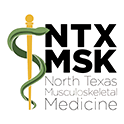CrossFit training is a beast unto itself. The strong communal nature of this sport helps to make it so. CrossFit entails more than just physical training:it is a way of life that views the body as a whole system rather than merely isolated structural elements. CrossFit practices feed the body though smart nutrition and clean eating for overall health. The holistic perspective includes how to nourish the body, physically, mentally and spiritually.
CrossFit involves varied, functional movement performed at high intensity. Activities include weight lifting, martial arts, and gymnastics. CrossFit athletes believe that it is effective because of the intensity. This intensity, however, makes Crossfit athletes prone to injury.
No CrossFit athlete wants to hear, “Take some time off.” As physicians specializing in musculoskeletal medicine, our job at NTXMSK is to listen, diagnose and get you quickly and safely back into the sport.
North Texas Musculoskeletal Medicine specializes in treating musculoskeletal injuries through procedures that maximize your natural healing process: regenerative orthopedics and osteopathic manipulation. We offer effective alternatives to surgery and medications that merely mask pain. Platelet Rich Plasma (PRP) Injections and Cell-based Therapy are procedures in an emerging field of medicine called "Orthobiologics," meaning substances that facilitate the healing of cartilage, bone, muscle, tendon, and ligaments... naturally.
Osteopathic Medicine is based on two philosophical tenets:
Unity of function. The entire body is interconnected through continuous series of sheathes that connect all parts. Its purpose is to provide support and reduce friction. Fascia has a large number of nerve endings, which means that it also plays a large role in proprioception and our body’s interpretation of pain.
In health, fluids flow with relative ease from one fascial compartment to the next. When a traumatic injury occurs, the fascia may twist and compress. The exchange of fluid may become compromised, and physiology may be impaired. Osteopathic manipulation helps to:
- Correct structural and tissue abnormalities in vertebrae, muscles,
myofascial structures, etc. - Relieve joint restriction and misalignment
- Restore muscle and tissue balance
- Promote the movement of bodily fluids
The body has a innate tendency to heal itself. This concept is central to Orthobiologic Procedures that seek to maximize our natural healing process.
Natural forces within us are the true healers of disease. ―Hippocrates
PRP
Platelets, once thought to be only for clotting of the blood, are generally the first cells on the scene of an injury and play a key role in initiating and coordinating the healing process. Science now shows that platelet cells contain packets of healing and growth factors call alpha granules. Platelets release proteins and help to stimulate resident cells to activate localized healing.
Stem Cell Therapy
Chronic conditions or just plain aging can cause an insufficient amount of stem cells and necessary growth factors to be available at an injured site. Bone Marrow Aspirate Concentrate Therapy harvests bone marrow rich in mesenchymal stem cells (MSCs) and through target injection replenishes the supply cells needed for tissue repair. These multipotent stem cells are able to differentiate into cells specialized types of cells, such as osteoblasts (bone cells), chondrocytes (cartilage cells), myocytes (muscle cells), and fibroblasts (ligament and tendon cells).
MSC treatment is an especially good option for treating musculoskeletal conditions involving lost or injured tissue, such as bone-on-bone arthritis; injury and tears to tendons, ligaments, and cartilage and degenerative disc disease. MSCs not only differentiate into all the different cell types within a joint, they also control the local inflammatory response, signal other cells to rush to the area to help, and modulate the immune system.
A study by Ohio State University published in the Journal of Strength and Conditioning Research states that 16 percent of CrossFit participants dropped out due to “overuse or injury”—an amount the researchers consider notable. Scientists say that this rate is associated with higher rates of musculoskeletal injury.
Osteopathic physicians have the same medical training as MDs, but with additional training in the musculoskeletal system. They are trained to diagnose and treat musculoskeletal conditions often undetected by traditional imaging. A Doctor of Osteopathic Medicine will exam range of motion and palpitate tissue to discover small impingement and restrictions that inhibit motion and can lead to more serious tissue damage.
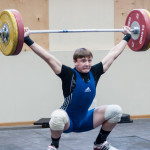 For example, a CrossFit athlete with a shoulder injury requires a physician with a higher level of understanding of biomechanical function typical in CrossFit movements: overhead squats, snatches, push presses, thrusters, and push jerks. These common movements place load on the shoulder which is not typically a weight-bearing joint. These movements make the shoulder joint susceptible to rotator cuff and labral tears, conditions generally requiring extensive periods of time for rehabilitation.
For example, a CrossFit athlete with a shoulder injury requires a physician with a higher level of understanding of biomechanical function typical in CrossFit movements: overhead squats, snatches, push presses, thrusters, and push jerks. These common movements place load on the shoulder which is not typically a weight-bearing joint. These movements make the shoulder joint susceptible to rotator cuff and labral tears, conditions generally requiring extensive periods of time for rehabilitation.
CrossFit athletes tend to injure soft tissue in five main areas: lower back, knees, wrists, shoulders and elbows. Treatment for these injuries have traditionally included medication to mask the pain, extended periods of rest, or invasive surgery involving lengthy recuperation time. Regenerative Orthopedics treats injury by using the body’s natural healing cells and targeted injection at the site of injury. Healing is faster amd more complete.
Common areas of injury for CrossFit athletes:
Lower Back
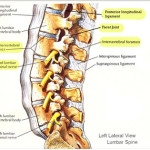 The lumbar vertebrae consist of five individual cylindrical bones that form the spine in the lower back. These vertebrae carry all of the upper body’s weight while providing flexibility and movement to the trunk region. This is why keeping core muscle control and correct movement pattern is so important. These vertebrae also protect the delicate spinal cord and nerves within their vertebral canal.
The lumbar vertebrae consist of five individual cylindrical bones that form the spine in the lower back. These vertebrae carry all of the upper body’s weight while providing flexibility and movement to the trunk region. This is why keeping core muscle control and correct movement pattern is so important. These vertebrae also protect the delicate spinal cord and nerves within their vertebral canal.
Connecting each vertebra to its neighboring vertebra is an intervertebral disk made of tough fibrocartilage with a jelly-like center. The outer layer of the intervertebral disk, the annulus fibrosus, holds the vertebrae together and provides strength and flexibility to the back during movement. The jelly-like nucleus pulposus acts as a shock absorber to resist the strain and pressure exerted on the lower back.
When lifting heavy weights again and again, all it takes is one lift with bad form and weak abdominal muscles to feel the sharp jab of pain. Whether from a strain, herniated disc, sciatica or multiple other reasons, lower back pain should not be ignored. Read more...
Knee
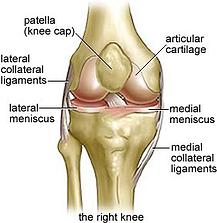 The knee joint is one of the strongest and most important joints in the human body. It allows the lower leg to move relative to the thigh while supporting the body’s weight. It is made up of bones, ligaments, tendons, cartilage, and muscles that are able to support up to 8 times our body weight.
The knee joint is one of the strongest and most important joints in the human body. It allows the lower leg to move relative to the thigh while supporting the body’s weight. It is made up of bones, ligaments, tendons, cartilage, and muscles that are able to support up to 8 times our body weight.
The joint-forming surfaces of each bone are covered in a thin layer of hyaline cartilage that gives them an extremely smooth surface and protects the underlying bone from damage. Between the femur and tibia is a figure-eight-shaped layer of tough, rubbery fibrocartilage known as the meniscus. The meniscus acts as a shock absorber inside the knee to prevent the collision of the leg bones during strenuous activities such as running and jumping.
Strong ligaments surround the joint capsule of the knee to reinforce its structure and hold its bones in the proper alignment. Two internal ligaments – the anterior and posterior cruciate ligaments – also help to maintain the proper alignment of the knee.
The knee is intricately connected to the pelvis, hip, upper and lower legs, ankles and feet. Many times knee injuries are simply manifestations of other areas of weakness that fail to support the knee. Read more...
Wrist
The wrist is an area of the body that is often overlooked by most athletes. Mobility and strength of the wrist is important whether you are lifting a Clean and Jerk or typing an email at work. The wrist is an intricate web of tendons, ligaments and bones, working at incredible levels of flexibility to provide daily function. Read more...
Shoulder
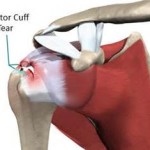 The most flexible joint in the entire human body, the shoulder joint is formed by the union of the humerus, the scapula (shoulder blade), and the clavicle (collarbone). Commonly thought of as a single joint, the shoulder is actually made up of two separate joints – the glenohumeral and acromioclavicular joints. These two joints work together to allow the arm both to circumduct in a large circle and to rotate around its axis at the shoulder.
The most flexible joint in the entire human body, the shoulder joint is formed by the union of the humerus, the scapula (shoulder blade), and the clavicle (collarbone). Commonly thought of as a single joint, the shoulder is actually made up of two separate joints – the glenohumeral and acromioclavicular joints. These two joints work together to allow the arm both to circumduct in a large circle and to rotate around its axis at the shoulder.
Both of these joints are held together by extensive ligament and muscle attachments. The shoulder joint is vulnerable to dislocations from sudden jerks of the arm. Dislocation of the shoulder is extremely painful and may cause permanent damage.
Chronic or acute wear and tear on the glenohumeral joint can lead to the painful tearing of the tendons of the rotator cuff or a torn labrum. Read more...
Elbow
The elbow joint is a complex hinge joint formed between the distal end of the humerus in the upper arm and the proximal ends of the ulna and radius in the forearm. The elbow allows for the flexion and extension of the forearm relative to the upper arm, as well as rotation of the forearm and wrist.
Because so many muscles originate or insert near the elbow, it is a common site for injury. Heavy lifting puts uncommon strain on this joint making it subject to strains and tears. Read more...
We Can Help
To learn more about what we can do to help with your condition, call our office at 817.416.0970. We will thoroughly diagnose your condition and present you with treatment options. From there we will guide you along your road to recovery.
